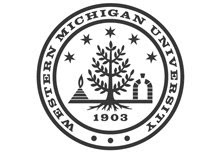Last spring the hydraulic bike was a creative design of one of IME’s senior capstone projects; this month a model created from that project competed in the Parker Chainless Challenge, a two-day event sponsored by Parker Hydraulics Group World Wide and held in Cleveland, Ohio, where the company is headquartered.
Michael Desgardins, a manufacturing technology major from Port Huron who graduates in December, and Elsamawal Mohamed, a graduate student in the manufacturing program, guided the bike to a fifth place finish.
For their senior project, Desjardins and now alumni Jacob Bacon (MFT), Gregory Kobrzycki (MFT), and Anthony Lipke (EGR) designed a hydraulic bike that transfers energy to the driving wheel through a hydraulic media and stores energy for uphill motion. They tested the hydraulic circuit in the lab and performed finite element analysis on a recumbent frame to ensure its structural integrity.
Mike Desjardins operates the hydraulic bicycle model that he and three others designed as a senior capstone project and presented in April.
When the other three members of the team graduated and Desjardins became involved with his final classes, Mohamed joined the team to update the design and fabricate the system. He spent two months building the hydraulic bike model. The task was challenging. “Everything was hard,” he said.
Mohamed credited IME lab coordinator Glenn Hall for providing the machining expertise and effort required to create the parts needed for the bike.
Graduate student Elsamawal Mohamed (left) shows off the hydraulic bicycle model that was built by the team. The bike design was developed by a Spring 2005 senior design team advised by Dr. Alamgir Choudhury (center) and sponsored by Parker Hannifin Corp. Michael Desjardins (right), a member of the bike’s four-man design team, rode the bike in the competition.
Last year Parker funded hydraulic bike designs at 10 colleges; at WMU, Parker also provided the lab that IME Professor Alamgir Choudhury, the advisor for the bike project, and MAE Professor Dr. James Kamman use for work in hydraulics and pneumatics.
Nine of the colleges participated in the challenge. Parker is currently seeking input to improve next year’s event. To prepare for it, Choudhury is planning to organize two senior design projects. One would work to improve the design of the current bike and the other would focus on designing an upright hydraulic bike using a standard bicycle frame.
To improve WMU’s odds of winning the next competition, Choudhury would like to involve sophomores and juniors in the project.
“The schools that did very well – like the University of Illinois at Urbana-Champaign [which earned first place] – were successful because all levels of students were involved in the project,” he said. “Sophomores and juniors learn about the project and take over when the seniors graduate.”











